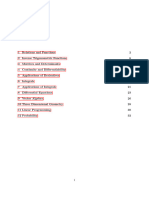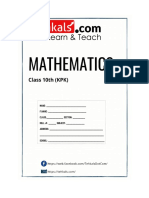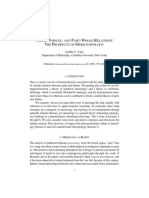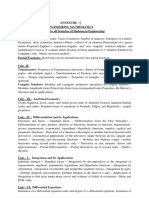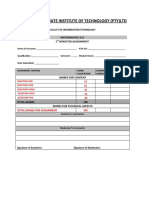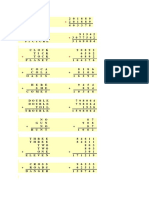ST
U
D
YG
U
ID
E3
1
60
�2
ST
U
D
YG
U
ID
E3
60
� ONE MARK QUESTIONS
60
E3
ID
U
YG
D
U
ST
3
� 8.
60
9.
10.
E3
11.
12.
13.
14.
ID
U
15.
YG
16.
17. State the reason for the relation R in the set {1,2,3} given by R={(1,2),(2,1)}
not to be transitive.
D
18. If R= {(x,y): x+2y = 8} is a relation on N, write the range of R.
U
19.
},
ST
20. Consider the set A= {1,2,3}. Write the smallest equivalence relation R on A.
4
� 21.
Then the set R.
x
22. f: ® f(x) 1+x
2 x
60
23. f(x) = f–1(x).
24. Let A= {1,2,3} and B= {4,5,6,7} and let f = {(1,4), (2,5), (3,6)} be a function from
A to B. State whether f is one-one or not.
E3
25. If A={1,2,3,4} and B={-1,3}, then what is the number of onto functions from A to B?
26. If A={-1,2,3} and B= {0,3,5} then what is the number of bijections from A to B?
ID
27. If A= {-1,2,3} and B= {0,3,5,7} then what is the number of bijections from A to B?
TWO MARK QUESTIONS
1.
U
YG
2.
3.
D
4.
5.
U
6.
ST
7.
8.
5
� 9. on
Î
60
10. Let A={2,4,6,8} and R be the relation “is greater than” on the set A. Write R as
a set of order pairs. Is this relation
Justify your answer.
E3
11.
Î
1.
ID
FOUR MARK QUESTIONS
U
2.
YG
3.
D
4.
U
5.
6.
ST
6
� 7. A×A iff
60
8. Show that f:N N given by
x+1, if x is odd
f(x)= x-1, if x is even
is both one-one and onto.
E3
9. Consider f: R+ ® [4,¥) given by f(x)=x2+4. Show that f is invertible with the inverse
–1 –1
‘f ’ given by f (y) = y – 4 , where R+ is the set of non-neagative real numbers.
x-1
10. = if : ®
x-2
11. : ®
ID x x Î
U
12. Prove that the relation R in the set A={5,6,7,8,9}, given by R={(a,b):|a-b| is
divisible by 2} is an equivalence relation. Final all elements related to element 6.
YG
n-1, if n is odd
13. ®
n+1, if n is even
numbers.
SIX MARK QUESTIONS
D
U
ST
7
� 5 23 ® ®
60
x x " Î f–1og–1
–1 –1
f og ?
6 ® 2
f(x)=x -x,
E3
Î l Î
x x x
x
7 Consider f: R+®[-9,¥) given by f(x)=5x2+6x-9, where R+ is the set of all
non- invertible
ID
U
YG
D
U
ST
8
� ONE MARK QUESTIONS
60
E3
ID
U
8.
YG
D
U
ST
9
� 16. ______
17. (1,2) Î R and (2, 1) Î R but (1, 1) Ï R
60
18. Range = {1, 2, 3}
19. Reflexive and symmetric but not transitive.
20. {(1, 1), (2, 2), (3, 3)}
E3
21. {(3, 8), (6, 6), (9, 4), {12, 2}
x
22. (fofof)(x) =
–1
3x 2 +1
23. f (x) = 7 +(4 – x) 3
ID
24. Yes
25. 14
26. 6
U
27. 0
TWO MARK QUESTIONS
YG
D
U
ST
10
� 60
9. R is reflexive, not symmetric, not transitive.
10. R = {(8, 6), (8, 4), (8, 2) (6, 4), (6, 2), (4, 2)}
(i) Not reflexive (ii) Not symmetric (iii) Not equivalence relation
11. R is not reflexive, R is not symmetric, R is transitive.
E3
4 MARK QUESTIONS
7.
10. f –1(x) =
2x – 1
x –1
ID
Equivalence class [(2, 5)] = {(1, 4), (2, 5), (3, 6), (4, 7), (5, 8), (6, 9)}.
U
11. a = 1 and b = 0 or a = –1 and b can be any real number.
12. {6, 8}
YG
y + 1, if y is even
13.
–1
f (y) = { y – 1, if y is odd
6 MARK QUESTIONS
D
U
5. (gof)–1 = {7, 1}, (23, 2), (47, 3), (79,4)}
f–1of–1 = {(7, 1), (23, 2), (47, 3), (79, 4), Yes (gof)–1 = f–1og–1.
ST
1
6. (gof)(x) = 2 x 2 - x - -1
2
54 + 5y – 3
7. f–1(x) = f–1(2) = 1, f–1(18) = 9
5 5
11
























